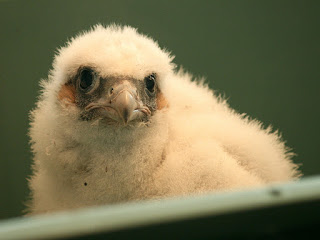
Alaskan Peregrine Falcon
Image source: Flickr
The Peregrine Falcon, with their ability to dive for prey at over 240 miles per hour, is considered among the world's most powerful animals. From the tundra of the Arctic to the desert regions of Africa and North American cities, these spectacular birds are known all over the world. In this article, we're going to learn everything about the physical characteristics of Peregrine Falcons, their hunting technique, and how they play an ecosystem role.
Physical Characteristics
Peregrine falcons are medium-sized birds of prey, measuring between 14 and 19 inches in length and weighing between 1 and 2 pounds. They've got a wingspan of about three or four feet so they can fly through the air at incredible speed and quickness. Peregrine Falcons are known for their distinctive dark head and nape, with a white face and black "mustache" stripe. Their backs and wings are gray in colour, while their inner parts are covered with black stripes. These markings serve as a means of identifying different birds in the wild.
Habitat and Distribution
Except for Antarctica, Peregrine Falcon is known to exist all over the world. They prefer to live in open spaces, e.g. coast cliffs, mountains, and deserts. It is also known that the Peregrine Falcon, which nests in high structures as their breeding sites, thrives in city environments. Due to the use of DDT, a pesticide that can cause eggshells to crack and fall apart, Peregrine Falcons almost disappeared from North America. Peregrine Falcon populations are back on track as a result of conservation efforts, and once again they can be seen in cities across the continent.
Diet and Hunting techniques
The Peregrine Falcon is a carnivorous bird of prey that feeds mainly on other birds. Their diet is dominated by pigeons, doves, and songbirds but they are also known to eat birds of various species such as ducks, shorebirds, or even bats. Peregrine Falcons are aerial hunters, using their speed and ability to hunt down prey in midair. They're also known to use the technique of "stoop hunting," where they drop from great heights, and strike their prey with incredible force. Peregrine's Falcon has a velocity of more than 240mph while diving, making it the fastest animal on Earth.

Peregrine Falcon Chick
Image source: Flickr
Breeding and Nesting
The Peregrine Falcon is a monogamous species, with pairs mating for life. They typically breed in the spring, with females laying 3-4 eggs in a scrape or depression on a cliff ledge or tall building. The eggs are incubated together by both parents and the chicks hatch in about 35 days. The chicks are born covered in white down feathers and are fed a diet of regurgitated food by their parents. The chicks begin to flee or learn to fly after around six weeks, and after another four to six weeks, they are ready to leave the nest.
Conservation Status
Due to pesticide use, the Peregrine Falcon was once wiped out but their population has been restored thanks to conservation efforts. They are currently protected by the International Union for Conservation of Nature but continue to be subject to threats such as habitat loss and human disturbance. Many countries protect the Peregrine Falcon through legal provisions, and there are strong restrictions on pesticide use that might harm them.
Conclusion
The Peregrine Falcon is, in fact, a very extraordinary animal with unbelievable speed, quickness, and ability to hunt. All over the world, they are admired by bird watchers and wildlife lovers because of their distinctive markings and adaptability. While Peregrine falcons have been faced with serious challenges in the past, they are thriving as a result of efforts to protect them and can be seen by all.
